Smaller than you might think, yet packed with novel features
Canon's official press release
(NB: Image illustration quality is not up to our usual standards in this article because of the low brightness artificial light available in the meeting room.)
The new Canon compact digital camera maybe a flagship but it is compact enough to snuggle in the palm of my hand.
I've had a brief play with Canon's new compact digital camera flagship, the Power Shot Pro 1. Featuring 8 megapixels of resolution and a wide range (28-200mm equivalent) zoom, with L-series rated glass incorporating special anti-dispersion and fluorite elements, plus ultrasonic motor (USM) technology, the Pro 1 is a remarkable camera.
The 8 megapixel era is here
If there is one thing that has marked this week's PMA show here in Las Vegas, it has to be the rush of 8 megapixel cameras from Canon, Minolta and Olympus. Sony beat them all to it by per-announcing the first 8 megapixel offering, the DSC F-8282, last summer. As Sony actually makes the 8 megapixel 2/3rd inch sensors used by all of these manufacturers, we shouldn't be too surprised.
Conventional
One thing Sony retains uniquely is that special version of the CCD sensor chip which incorporates a Bayer filter numbering four colours, adding 'emerald' to the usual red green and blue. The jury remains in a huddle over the benefit of this innovation, but it's not a concern to the other manufacturers who make do with a conventional RGB chip.
Smaller than you might think
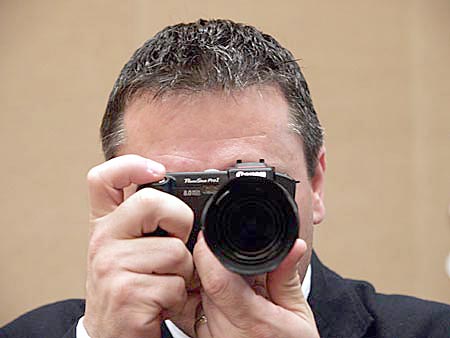 Nigel Atherton, editor of What Digital Camera magazine, tries the diminutive Pro 1 for size.
Nigel Atherton, editor of What Digital Camera magazine, tries the diminutive Pro 1 for size.
First impressions of the Canon Power Shot Pro 1 are – "it's
that small???" Compared to Sony's DSC F-828, for example, the Pro 1 is a dwarf even though the two share surprisingly similar specifications – 28-200 zoom, 8 megapixels, etc.
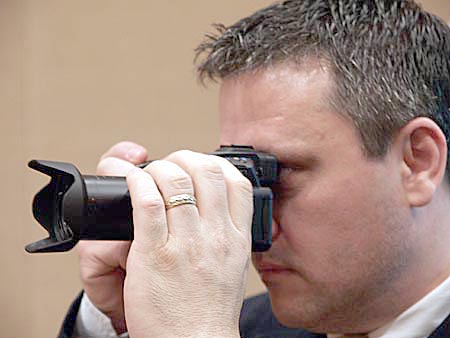 Here Nigel has zoomed the Pro 1 to near its fullest tele extent, showing the way the lens extends physically
Here Nigel has zoomed the Pro 1 to near its fullest tele extent, showing the way the lens extends physically
The Pro 1's compact dimensions are partially explained by its relatively modest maximum aperture of f/2.4 compared to the F828's f/2.0. The Pro 1's lens also extends considerably when set to telephoto zoom.
 Notice the markings on the lens barrel. These indicate the zoom setting in 35mm system-equivalent focal lengths.
Notice the markings on the lens barrel. These indicate the zoom setting in 35mm system-equivalent focal lengths.
The electronic viewfinder benefits from the latest 235,000 pixel resolution common to the Pro 1's peers and Canon's implementation looks good, with some critical focus possible at eye level. Common to the G5 and some new Power Shot A and S-series models, the Pro 1 has a flip-out and twist LCD viewscreen. With the same 235,000 pixels as the EVF and a decent 2 inch diagonal dimension, it's a key asset of the camera.
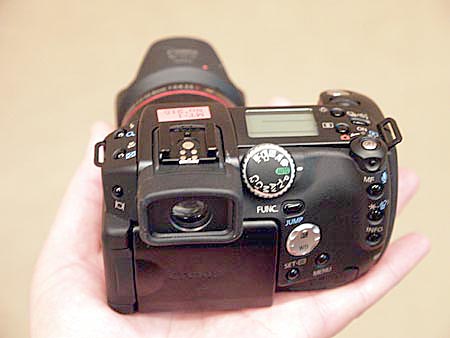 From the back you can see the large angled mode dial and the folded swing-out LCD viewscreen.
From the back you can see the large angled mode dial and the folded swing-out LCD viewscreen.
In the hand the camera feels good, with a nicely shaped, if small, grip. There is the same feel of solid construction that one experiences with the Power Shot G5. Indeed, if you are familiar with the G3 or G5, you will find yourself at home with the Pro 1 very quickly.
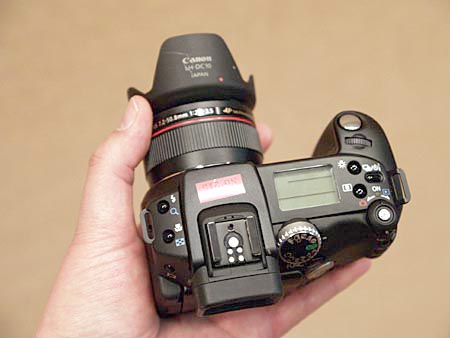 From the top the generously proportioned top plate LCD status screen is visible, as is the generously moulded hand grip.
From the top the generously proportioned top plate LCD status screen is visible, as is the generously moulded hand grip.
Overall and considering the Pro 1's specification, it's a marvel of compactness and detail finish. But examining the specification closer and examining the camera closely in the hand even for the short period I had did reveal some worrying facts.
A few concerns
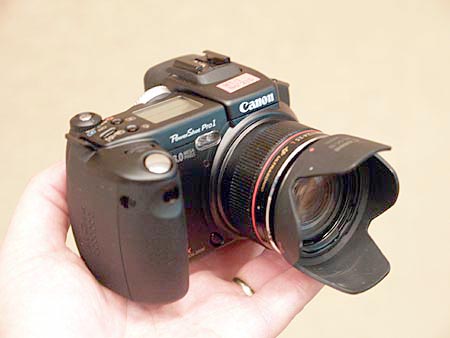 Opinion among fellow journalists is that the Pro 1 is functional and practical looking rather than a work of beauty. But it certainly makes an impression and can be mistaken for Konica Minolta's Dimage A1/A2.
Opinion among fellow journalists is that the Pro 1 is functional and practical looking rather than a work of beauty. But it certainly makes an impression and can be mistaken for Konica Minolta's Dimage A1/A2.
Eventually, test reports of final production samples will form a better picture of how good the Pro 1 really is, but among the positive aspects of the camera I have already covered, there are some oddities that surprise me.
I mentally welcomed the letters 'USM' in the Pro-1 specifications when I first read them, but to my disappointment the reality is that this doesn't mean the Pro 1 is endowed with the same quick and silent USM autofocus system that Canon EOS SLR users enjoy. Instead, Canon has used its ultrasonic motors to drive the electronic zooming action, which is operated by a rubber collar at the base of the lens.
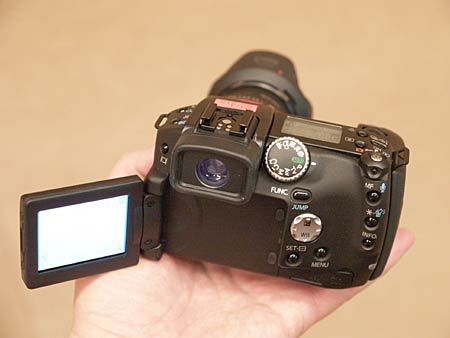 This view shows the viewscreen swung out. There are plenty of external case buttons for direct access to camera functions.
This view shows the viewscreen swung out. There are plenty of external case buttons for direct access to camera functions.
The problem with this is that the zooming action is stepped so very precise framing of your subject, easily possible with a mechanical zoom control, is not possible with the Pro 1. But it is quiet and that means when using the camera in video movie mode there will be minimal zoom motor noise to spoil your enjoyment, but was this consideration really that important for a camera of the Pro 1's purpose?
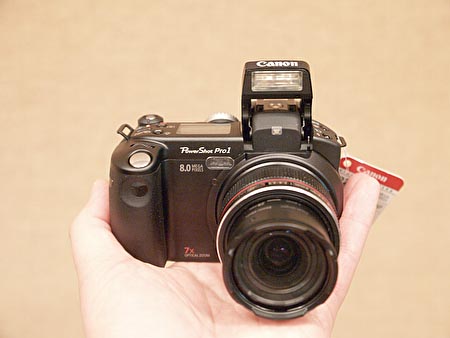 The whole housing above and behind the lens pops up to reveal the generously proportioned flash unit.
The whole housing above and behind the lens pops up to reveal the generously proportioned flash unit.
Another strange omission is that of image stabilisation. The Pro 1's immediate predecessor was the Pro 90is. Those 'is' letters stood for 'image stabiliser' and, while the Pro 1 zoom range doesn't extend quite as far as the old Pro 90's 10x optic, inclusion of a stabiliser function might have been expected by many. According to one source at Canon the compact dimensions of the Pro 1 prevented its inclusion and it was assumed that this feature was not critical for pro or semi-pro users the camera is aimed at.
So, my brief hands-on experience of the Canon Power Shot Pro 1 left me with mixed feelings. Canon needs to persuade me that the electronic zoom system was put together with enough thought. It's probably that the compact nature of the lens, especially when stowed away powered-off, forced their hand, removing the option of a manual zoom ring. Also, Canon labels the Pro 1, well, a professional camera. Again, with a camera this small, would a true professional consider it an alternative to a conventional Digital SLR?
The debate is sure to rage about this landmark camera from Canon. All I can say for now is that I can't wait to try a full production model out.
Canon's official press release




